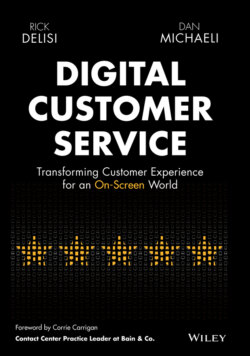Читать книгу Digital Customer Service - Rick DeLisi - Страница 34
CUSTOMERS HAVE TRANSFORMED; SO SHOULD YOUR COMPANY
ОглавлениеThe assumed solution to overcoming the challenges of creating an excellent experience for increasingly empowered (and in some cases entitled) digital customers has been: Companies must “meet their customers where they are.”
This has generally been interpreted as “meet them in the channel where they started their interaction.”
And of course, most likely that is not the phone anymore – but rather, your website, mobile app, or social media sites like Facebook and Twitter – so the conventional wisdom is that you need to meet them there. And while this seems correct, we are learning that it is an underintrepretation of the concept.
To successfully transform customer service in a digital world, companies must “meet their customers where they are” in two other ways as well:
Meet them where they are at a specific moment in a resolution journey. By the time a customer speaks with an agent, that customer has already been through some form of misadventure that very likely began online. Companies can no longer greet customers at the outset of a phone interaction like it's the starting point for that person's service journey, because it almost certainly isn't.Where they are – is in the middle of their digital experience.
Meet them where they are in their digital lifestyles. Most customers now instinctively reach for their smartphone, tablet, or laptop as the starting point for interactions of all kinds as well as to satisfy their information, entertainment, and recreation needs. Companies need to create service experiences that feel like the way their customers now live.Where they are – is in the middle of their own digital transformation.
Your ability to meet your customers where they are in all three ways should become the beacon for the digital transformation of your service organization.
As much as customer behavior has been transforming over the past decade, the underlying psychology and sociology that drives those behaviors has been changing even faster. What we've been learning is that the more you understand and appreciate why this is happening, the easier it will be for you to create a strategy that can meet and exceed ever-escalating customer expectations in the digital world.
Here's a preview of what you can expect in the chapters to follow:
In Chapters 2 and 3 we will explore the evolution of service over the past decade, and the corresponding evolution of customer expectations and psychology.Why do so many customers have a negative bias against customer service, how does that impact their online behaviors – and what can companies do to overcome this negative predisposition?How did the advent of self-service lead to the unexpected consequence of setting a course of an ever-increasing demand for more and better digital experiencesBy understanding why customer psychology and behaviors have been transforming, it becomes that much more clear why you have to transform.
Chapter 4 provides us with a common language and vocabulary for understanding the benefits of transforming to DCS. The integration of OnScreen Communication, OnScreen Collaboration, and OnScreen Automation in the DCS platform will be described in full detail.
Chapters 5–7 are a step-by-step guide for how to move away from a service-operation-centered phone interactions that are disconnected from the digital experience – by focusing on three strategic areas:Process – how to get started with DCS and accelerate your progressPeople – how DCS changes the way your people work, and the satisfaction they get from their jobsPositioning – how DCS gives your company a competitive advantage and positions service as a true differentiator
